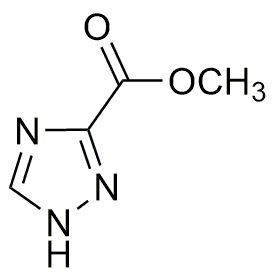Methyl 1,2,4-triazole-3-carboxylate is widely utilized in research focused on:
- Agricultural Chemistry: This compound serves as a key ingredient in developing fungicides, helping to protect crops from fungal diseases, thereby enhancing agricultural productivity.
- Pharmaceuticals: It is used in the synthesis of various pharmaceutical agents, particularly in the development of antifungal medications, offering effective treatment options for infections.
- Material Science: Methyl 1,2,4-triazole-3-carboxylate is employed in creating advanced materials with specific properties, such as corrosion resistance, which is beneficial in industries like automotive and aerospace.
- Biochemistry: Researchers utilize this compound in biochemical assays to study enzyme interactions, providing insights into metabolic pathways and potential therapeutic targets.
- Environmental Science: It plays a role in the development of biodegradable materials, contributing to sustainable practices and reducing environmental impact in various industries.
General Information
Properties
Safety and Regulations
Applications
Methyl 1,2,4-triazole-3-carboxylate is widely utilized in research focused on:
- Agricultural Chemistry: This compound serves as a key ingredient in developing fungicides, helping to protect crops from fungal diseases, thereby enhancing agricultural productivity.
- Pharmaceuticals: It is used in the synthesis of various pharmaceutical agents, particularly in the development of antifungal medications, offering effective treatment options for infections.
- Material Science: Methyl 1,2,4-triazole-3-carboxylate is employed in creating advanced materials with specific properties, such as corrosion resistance, which is beneficial in industries like automotive and aerospace.
- Biochemistry: Researchers utilize this compound in biochemical assays to study enzyme interactions, providing insights into metabolic pathways and potential therapeutic targets.
- Environmental Science: It plays a role in the development of biodegradable materials, contributing to sustainable practices and reducing environmental impact in various industries.
Documents
Safety Data Sheets (SDS)
The SDS provides comprehensive safety information on handling, storage, and disposal of the product.
Product Specification (PS)
The PS provides a comprehensive breakdown of the product’s properties, including chemical composition, physical state, purity, and storage requirements. It also details acceptable quality ranges and the product's intended applications.
Certificates of Analysis (COA)
Search for Certificates of Analysis (COA) by entering the products Lot Number. Lot and Batch Numbers can be found on a product’s label following the words ‘Lot’ or ‘Batch’.
*Catalog Number
*Lot Number
Certificates Of Origin (COO)
This COO confirms the country where the product was manufactured, and also details the materials and components used in it and whether it is derived from natural, synthetic, or other specific sources. This certificate may be required for customs, trade, and regulatory compliance.
*Catalog Number
*Lot Number
Safety Data Sheets (SDS)
The SDS provides comprehensive safety information on handling, storage, and disposal of the product.
DownloadProduct Specification (PS)
The PS provides a comprehensive breakdown of the product’s properties, including chemical composition, physical state, purity, and storage requirements. It also details acceptable quality ranges and the product's intended applications.
DownloadCertificates of Analysis (COA)
Search for Certificates of Analysis (COA) by entering the products Lot Number. Lot and Batch Numbers can be found on a product’s label following the words ‘Lot’ or ‘Batch’.
*Catalog Number
*Lot Number
Certificates Of Origin (COO)
This COO confirms the country where the product was manufactured, and also details the materials and components used in it and whether it is derived from natural, synthetic, or other specific sources. This certificate may be required for customs, trade, and regulatory compliance.


